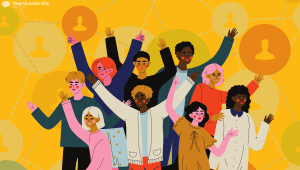
Beyond Representation: Why Equity and Inclusion Matter for Business Success
To realize the potential of diverse teams, organizations must move beyond mere representation to embrace equity and inclusion.
Thank you for searching the NeuroLeadership Institute archives. Here’s what we were able to find for you.
Still having difficulty finding what you’re looking for? Contact us.

To realize the potential of diverse teams, organizations must move beyond mere representation to embrace equity and inclusion.

Here’s how organizations can build DEI initiatives that are both legally compliant and strategically beneficial.

An NLI white paper provides practical advice on how organizations can harness diversity to improve business outcomes.

New research suggests people are more likely to have “aha” moments from information that came from members of their in-group.

Here are four things leaders must do to keep clear amid the chaos.

Organizations should think about their habits and reward systems to help women leaders thrive.

Nobel Prize-winning psychologist’s research on decision-making influenced The SEEDS Model®.

The five biggest leadership trends for 2024, according to NLI founder and CEO David Rock.

AI is as biased as the humans who created it. So, it’s up to us to detect and mitigate those biases.

When bias mixes with exploitative business practices, the result is performance punishment. Learn how to avoid giving all your hard tasks to one person.

We think of data as being unbiased, but it depends on how people choose to collect, analyze, and interpret the results.

Here’s how to recognize — and mitigate — the most common mental shortcuts.

Slowing down, thinking more analytically, and considering outside perspectives are just three ways to make the distinction.

Leaders today face a deluge of demanding tasks and a mounting confidence crisis. Here’s how to regain courage and conviction.

Here’s a look at what leaders can learn from having generational differences in the workplace.

While there are differences in how each generation communicates or prefers to work, “sometimes there are more similarities than differences.”

Five generations in the workplace provides plenty of opportunity for friction — and innovation.

Science-backed advice for surviving the holiday season.

Don’t miss out on the many upsides of candidates with “portfolio careers.”

Here’s why we should push ourselves out of our comfort zone at work.

With people changing jobs more often, leaders are seeing multigenerational ageism as an opportunity to rethink talent practices.

Studies show that power leads managers to focus on goals, not people. Here’s how to make employees feel cared for in a time of disconnection.

We spoke with three neurodiversity advocates about how to create more neuro-inclusive hiring practices and workplace cultures.

If you have a brain, you have bias. Some biases create bigger blind spots for decision-making, however. We’re seeing that a lot now as organizations try to redefine work and the employer-employee relationship.

Diversity training can feel performative, and elicit groans from those asked to attend. But it absolutely can be impactful, and that’s through a mix of both delivery and measurement.

NLI has worked for years to develop “sticky” acronyms to help people understand the brain science behind performance, learning, motivation, feedback, and dealing with bias. Here’s a brief summation of that work.

What three scientific elements should we focus on to create more inclusive Australian workplaces for the differently-abled?

Many workers won’t be returning to an in-office situation anytime soon. We know the biases baked into telework; now’s our chance to mitigate them.

“Don’t dismiss a good idea simply because you don’t like the source.” The brain science behind the twelve words that changed my life.

With DE&I are at the forefront of everyone’s mind, we’ve curated the resources to help leaders understand, and act on, the science.

Right now many leaders are asking how they can turn their companies anti-racist—that is, supporting an anti-racist policy through their actions, or expressing an anti-racist idea. It’s an important question, and we should all embrace the intent behind the inquiry.

Unconscious bias lives in everyone. For leaders, it’s exceedingly important to learn to mitigate that bias before it negatively impacts decision-making.

Bias and inclusion may appear together in D&I conversations, but from a scientific standpoint, they are undeniably different.

Performance conversations are a critical moment for leaders to help their team members feel supported and keep engagement steady.

With many employees working from home full-time, developing these five habits to mitigate distance bias is critical to good decision-making.

A distance bias occurs when we prioritize what’s closer in space or time than what’s farther away. Here’s how to mitigate the bias to prioritize better.

At NLI, we like to say “If you have a brain, you’re biased.” Ever since November 2017, the technology company Splunk has taken that insight to heart.

Bias isn’t just something that happens within a person. It also happens between people — namely, in meetings. Without meaning to, people at the head of the table routinely make mental shortcuts that save time, but also may impair decision-making. This expedience may feel good, but teams and organizations may ultimately suffer from the scarcity of input. The key to holding less biased meetings is diversity, a premise we explored in a recent Corporate Membership article called “How Diversity Defeats Groupthink.” The piece uses tested research to show how more diverse teams can cut through bias and improve decision-making. We’ve posted an excerpt below, featuring five strategies to help leaders change their behavior and incorporate greater diversity of thought. 1. Bite your tongue when you’re in charge As a leader, you naturally want to share what you know. But it’s important not to bias the discussion with the influence you wield. Next time you find yourself wanting to broadcast your opinion at the outset, remember to hold back until others have weighed in. 2. Solicit contrary perspectives People naturally want to get along, but that can make dissent feel unwelcome. Next time you sense team members hesitating to speak their minds, remind them it’s OK to disagree. The goal isn’t harmony, but good decisions. But you need to rotate the role of contrarian, so that it becomes a habit that people can employ. 3. Amplify quiet voices Bad decisions happen when team members keep their doubts and reservations to themselves. Next time you notice a discussion being dominated by a few vocal personalities, make a point of calling on those whose voices haven’t been heard. 4. Run the scenarios One way to defeat conformity is to change your time horizon. Next time your team’s plans start feeling too rosy, try projecting yourself into the future, running through scenarios and thinking through what could go wrong. Shifting your perspective can inject an important dose of reality and help you see through misplaced optimism. 5. Switch it up The more time you spend as a team, the closer you get. This camaraderie can be fruitful, as team members begin to share the same language and behaviors. But, dangerously, they can also think like each other. Next time that happens, make a point to shake things up. Swap in new people on the team, and shuffle roles. Change can be bittersweet, but it will help keep your team nimble and sharp. SEE ALSO: The Smartest Teams Embrace the ‘Diversity Paradox’
Join millions of employees in creating culture change at scale by reaching out today.

In 2007, David and Lisa Rock and their team had been working in leadership development and executive coaching for ten years, when David coined the term “NeuroLeadership.”ef

North America
Africa
South America
Asia
Europe
Australia
© NeuroLeadership Institute 2025. All Rights Reserved
This site uses cookies to provide you with a personalized browsing experience. By using this site you agree to our use of cookies as explained in our Privacy Policy. Please read our Privacy Policy for more information.